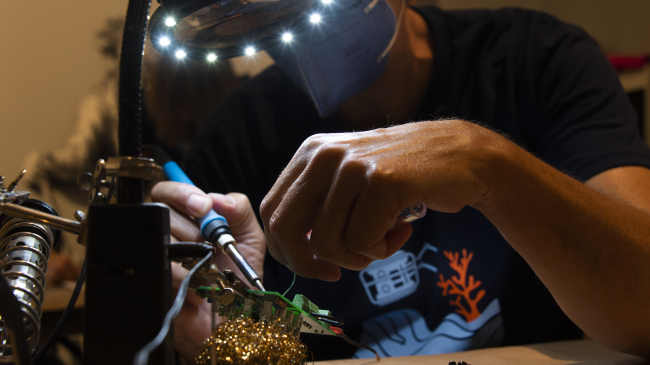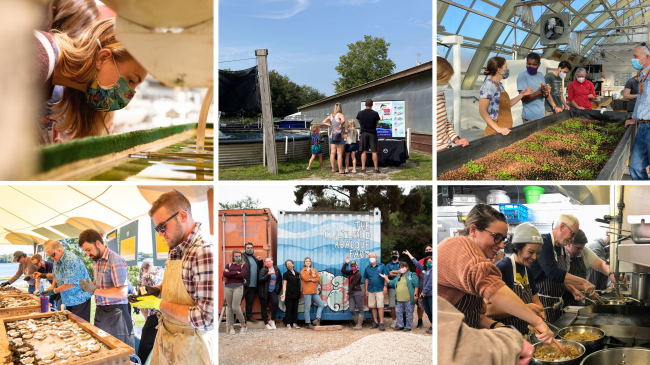8 employees share their proudest accomplishments and how the group has impacted their personal and professional lives.
Read all
More stories in Goal 5
NOAA's Diversity and Professional Advancement Working Group (DPAWG) focuses on attracting, retaining, supporting, and advancing a diverse NOAA workforce. Meet eight DPAWG members to learn about the work that the group has accomplished and the impact it has had on their careers.

Eight members of NOAA's Diversity and Professional Advancement Working Group. Clockwise from the top left: Vankita Brown, John Moore, Terence Lynch, Maddie Kennedy, DaNa Carlis, Lonnie Gonsalves, Ashley Turnbull, and Janae Elkins. (Image credit: NOAA)
Read all
More stories in Goal 5
In the eight years since the working group formed, its membership has grown from 14 NOAA staff to more than 60 employees located across the country. DPAWG received a 2016 NOAA Administrator's Award and was recognized as the fifth-best employee resource group offsite link (ERG) in the nation at the 2021 Diversity Impact Awards. DPAWG members have made waves in their careers while supporting each other and their coworkers across NOAA through the inclusive work environment they have built together.

Vankita Brown
Vankita Brown, Ph.D., is NOAA’s Senior Advisor for Equity, where she provides strategic advice and direction to extend the agency’s diversity, equity, inclusion, and accessibility efforts. A social scientist by training, Brown’s research focused on risk communication to vulnerable populations, specifically examining cultural nuances that influence perception and behavioral response to weather events. She co-chaired DPAWG from 2018-2022.
Describe a DPAWG activity that you’re particularly proud of.
One of the things that I’m proud of is the recommendations that we made to NOAA’s Leadership Competencies Development Program (LCDP) to “widen the door” for that program. LDCP is what I consider to be the agency’s premiere leadership development program. It’s 18 months, and each cohort has only around 30 people. You go through a series of trainings to really understand your own leadership style. You are also able to do assignments in other NOAA offices, which I think is a critical part of the program because you are exposed to other parts of NOAA and can build those networks. There are also job opportunities that come out specifically for LCDP-ers, so it’s really important to allow others to access that.
We looked at some data and understood that the majority of underrepresented groups in NOAA sit at or below the GS-12 pay band, and we know that LCDP is a gateway to leadership within NOAA. We thought it was critical for people to be able to participate, so we made recommendations to the acting administrator at the time, and he was willing to make adjustments to that program. One recommendation was to lower the pay band requirement for applicants from GS-13 to GS-11 to broaden the pool of people who were eligible to apply. One of the other barriers for participation was that you had to be sort of given permission from your supervisor to participate in the program before you even applied, and that cut off a lot of folks. Now there are these blind reviews where people can submit their application before their supervisor knows, which we thought was important. DPAWG has several former members of LCDP — and current members as well. I think in this one we carried the water from beginning to end, and I think it will have a lasting effect on the agency.
How has DPAWG impacted you personally and professionally?
For me personally and professionally, I found a home in DPAWG. I had been working for the agency for four-and-a-half or maybe five years. I came into NOAA as a social scientist — a rare creature in a NOAA space! In the Weather Service in particular, I was the only social scientist. DPAWG was a safe haven of folks who made me feel comfortable in a space where I wasn’t always and I didn’t always feel that my skill set was valued. The first thing we did in DPAWG, because we are a data organization, was create a survey — and that’s my wheelhouse. I create surveys. I was able to utilize my skill set and really be looked at as an expert. It was a really delicious coming together of things that I needed at the time: I needed to be seen and appreciated for my skill set and practice my passion for diversity as well. More than any one concrete thing that we have been able to deliver, creating space for people to be able to find themselves and take risks professionally that they probably wouldn’t be able to do in other spaces has been the proudest thing for me about DPAWG.
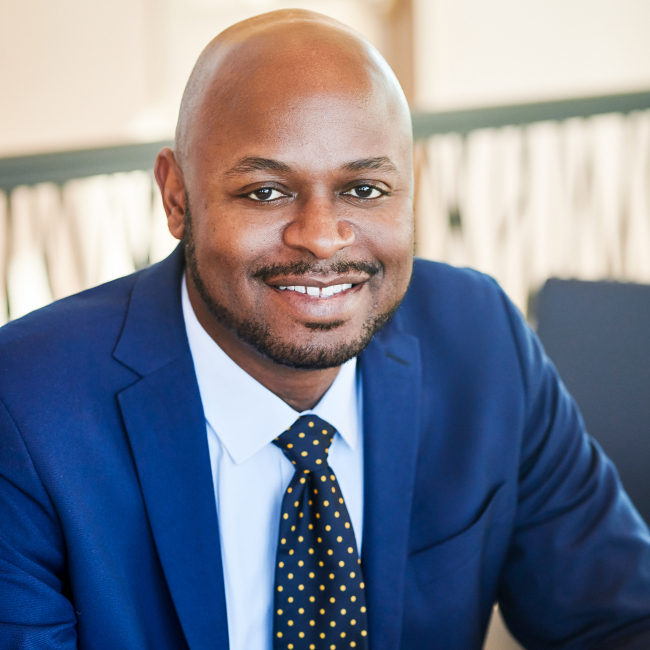
DaNa Carlis
DaNa Carlis, Ph.D., is the Director of the National Severe Storms Laboratory in NOAA Research. A research meteorologist with more than 20 years at NOAA, he enjoys working between science, policy, and society to ensure better products and services for the American people. Carlis co-founded DPAWG in 2014 along with Michele Hawkins, Ph.D.
Describe a DPAWG activity that you’re particularly proud of.
I’d like to talk about our involvement with the Diversity and Inclusion Summits that started around 2015, which was a big deal. DPAWG team members and I were involved in organizing, planning, and scoping out the entirety of that event. Close to 400 people came together in person at that conference to get trained on diversity and inclusion and to discuss how to move diversity and inclusion forward in NOAA. It was part learning and part action, but also an opportunity to come together to hear from diversity and inclusion professionals and continue to educate ourselves. We hadn’t had one in NOAA in probably 10 or 15 years prior to the one that we had in 2015. I thought that was a big accomplishment.
Now, after eight Diversity and Inclusion Summits, I would say that we are much more likely as an organization to have a conversation about diversity and inclusion. I think we’re more comfortable than we used to be. We had some difficult conversations about diversity and inclusion as an agency before, but we look at the summits being a factor in our ability to have difficult conversations and understand that it’s important that we have these types of discussions within the agency.
How has DPAWG impacted you personally and professionally?
I used DPAWG as a stepping stone into leadership. It was the first opportunity that I got a chance to lead a team of people towards specific outcomes. Since starting at DPAWG, I’ve been a program manager and team lead of five people into being a director of a national laboratory where we have over 150 people. I point back to my comfort and skill in directing and leading the DPAWG as one of the main contributing factors for me being successful in both of those areas. It has helped me in understanding what it means to lead. Especially with the DPAWG — it’s a volunteer organization, so there’s no accountability toward the leaders who are in place. The fact that people still come together, people are still active and involved in moving the agency forward through the DPAWG, I think is a really an amazing feat.
Janae Elkins
Janae Elkins is a Meteorologist at the National Weather Service (NWS) office in Jackson, Mississippi. Her responsibilities include analyzing and assessing the current forecast weather situation at both the upper and lower levels of the atmosphere and providing weather information for users in 58 counties and parishes in Mississippi, Arkansas, and Louisiana. Elkins knew she wanted to be a meteorologist since she was 6 years old.
Describe a DPAWG activity that you’re particularly proud of.
I would definitely have to say the 20% Podcast, reason being, it came during a time when community was needed most. It was during the pandemic or right before when my colleague John Moore and I started it up, and I remember it being helpful at the height of the unrest in 2020 and also with the pandemic. Basically what John and I do is we ask the group who they would like to be featured next and have a conversation with them. We called it the 20% Podcast to emphasize that only 20% of NOAA employees are minorities. I think that the podcast was a way to connect to other colleagues within DPAWG whom we haven’t had the chance or opportunity to meet with before, reason being, not everyone works in headquarters. Also, John and I are both graduates of Jackson State University, and John was actually one of my mentors. He’s one of the reasons why I’m at NOAA. I think that because we both know our working styles, we’re able to bounce ideas off each other. One of the things that John and I were able to do was be featured during the first ever We are NOAA Week. We had the chance to work with leadership, so that was a highlight for us because not everyone gets a chance to do that. I’ve been at NOAA for four-and-a-half years, and as an early-career employee, that was definitely something that I am proud of.
How has DPAWG impacted you personally and professionally?
Personally, I would say that, just as with the podcast, I have been able to reach out and network with people that I’m almost certain I would not have had the chance to meet if I wasn’t in DPAWG. I’m in a field office; we’re very detached from headquarters, and most of the people in DPAWG work at headquarters. It opened me up to a lot of different jobs that I didn’t even know NOAA had. DPAWG is always sending out something about a detail or job opportunity. I also sit on the executive committee council, so it helped me to build up my communication and leadership skills. But also, DPAWG gives me something to look forward to and to look up to. I look at people who came before me, and I’m like, wow, I can achieve this because they did. If I’ve had a rough time and they’ve had a rough time, but they were able to get through it, I know I’ll be able to get through it. It definitely is like a big family.
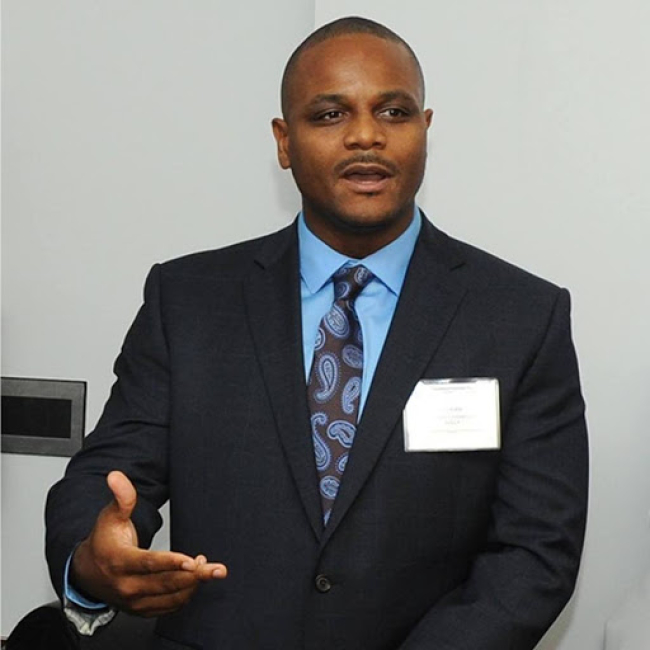
Lonnie Gonsalves
Lonnie Gonsalves, Ph.D., is the Division Chief of the Stressor Detection and Impacts Division at the National Centers for Coastal Ocean Science. Formerly, he managed NOAA’s highly interdisciplinary ecological forecasting portfolio where he was responsible for coordinating cross-NOAA research and operations that deliver forecasts for harmful algal blooms and other environmental hazards. He is a proud champion for diversity, equity, and inclusion in ocean and atmospheric sciences.
Describe a DPAWG activity that you’re particularly proud of.
DPAWG took a concerted approach to focus on three areas: recruitment, retention, and advancement. Our approach was to organize grassroots and staff-level activities that could increase the brand awareness of NOAA to make sure that diverse communities understood the interdisciplinary nature of our science, understand where their skills and interests fit, and encourage them to apply for NOAA’s jobs and student opportunities. For example, we’re looking to use uncrewed systems and cloud computing and all kinds of new modeling techniques to drive NOAA science into the future. In order to do that, we need people who are skilled in computer science, artificial intelligence, and engineering. We understood that we had so many candidates out there from diverse communities, coming from minority serving institutions, for example, who don’t know NOAA, but if they did, would be attracted to bring their skills and expertise into the agency.
We took deliberate steps early on within DPAWG to advance recruitment. We started off as simple as going to local schools and science fairs, for example. But I’m proud of how we have continued to grow and to galvanize across NOAA. That led to our biggest success so far because two offices stepped forward to sponsor NOAA engagement with large national, diversity-oriented professional organizations, in this case, the Society for the Advancement of Chicanos/Hispanics and Native Americans in Science offsite link (SACNAS) and the National Society of Black Engineers offsite link. DPAWG was at the forefront of organizing the cross-NOAA team of some 30 individuals who contributed to our engagement at SACNAS this year. I’m very proud of what we started at a grassroots level that has grown to have this NOAA-wide impact. And we’ve set things up that are sustainable to push forward for the entire agency.
How has DPAWG impacted you personally and professionally?
We always say when we come together that it feels more like a family reunion than just another meeting. We have been here to support each other and to get to know each other in a way that has been enormous in adding a sense of belonging for everybody in our group. When I went through some tough times, there were a lot of DPAWG individuals who were there checking on me, giving me encouragement, and letting me know that they were there in my corner. It was huge. I think about some of the professional challenges that were ongoing at that time, and if I didn’t have the support structure, it would have been very hard to keep moving forward.
Professionally, DPAWG has been huge — I come back to that advocacy and support. I know that I have been able to step into roles because DPAWG members were there to put my name forward for various opportunities. Without that advocacy, those opportunities don’t necessarily come. I wouldn’t be in my division chief spot if it wasn’t for the opportunities that I had leading up to this. And I think about sitting in the division chief spot — it was the biggest interview I had in my life, and DPAWG team members were a big part of my prep. I knew that after talking with so many of my colleagues, I was ready. It was because of that encouragement and assistance from DPAWG that I felt like I could shine my best when it came to that interview. And I got the position. That doesn’t happen without a support system and a network like DPAWG being there to help support and navigate for you.
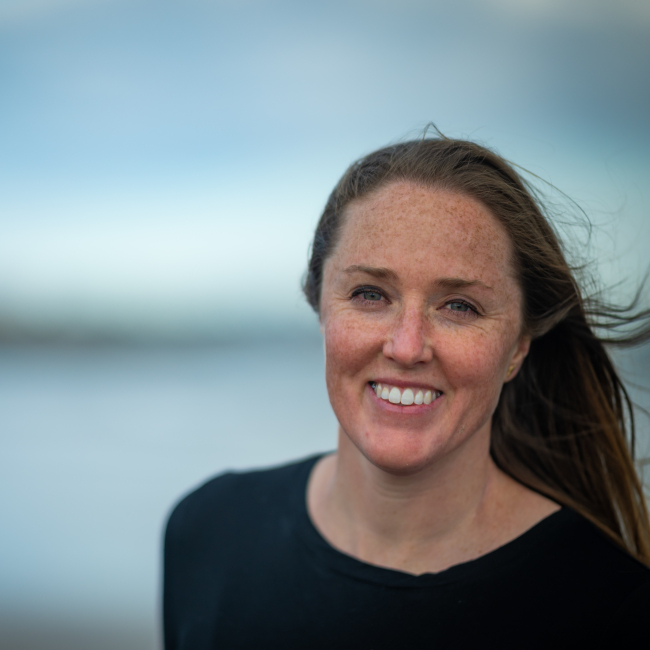
Maddie Kennedy
Maddie Kennedy is the National Student Opportunities Manager for the National Sea Grant College program. She is responsible for the administration of the Knauss Marine Policy Fellowship and the NOAA Fisheries-Sea Grant Fellowships as well as the facilitation of collaboration across NOAA fellowships. She is interested in helping students jump-start their careers and has a passion for supporting diversity, inclusion, and belonging in science, technology, education, art, and math.
Describe a DPAWG activity that you’re particularly proud of.
I’m really excited about our student engagement form. It’s a brainchild that John Moore and I came up with. I went to a conference, and students kept coming up to me and saying, “I’m really interested in this.” And I would say, “I cannot help you because I know nothing about that.” I know nothing about weather broadcasting, for example. It was from this frustration that we had the idea to create a way that students can tell us what they’re interested in, and then after the fact we can connect them to people who are doing those jobs.
Our tool is still going through an approval process but when it’s approved, we’ll be able to share a QR code, and students will be able to scan it and tell us what they’re interested in. We also created an internal form that’s going to go out to NOAA folks where they can tell us if they’re interested in talking to students. We can cross-reference after major conferences and make those one-on-one connections, whether it’s a one-off conversation or becomes a casual, continual mentorship. Because we know that the primary way to scoot people into NOAA is to make those relationships, build those connections. It’s opening up our reach to students and saying, “Hey, we are welcoming, we are humans, we do want to talk to you, and we do want to mentor and provide that guidance.” I think that’s one thing that’s cool about this group, too, is that we’re willing to try new things. And because we all come from such different backgrounds — I’m in student opportunities, John is in weather — none of us are doing the same thing, which makes everything that much richer.
How has DPAWG impacted you personally and professionally?
Oooh, I don’t know if I've been in long enough to truly answer that question! I’ve only been part of it for a year. But I think what it’s done is open up this whole world of support to me. There’s this whole new world of people that I feel comfortable reaching out to and asking questions, which in my personal job is very beneficial because my whole job is to make a program for NOAA more inclusive and more welcoming.
It’s also really empowering to just work with all these really cool, smart, awesome, passionate people who are all doing amazing things. I get inspiration every time I talk to them. It’s really fun to see the NOAA Administrator’s award and say hey, I know all these people! That’s not something I ever had before. I think one thing that is kind of cool is that I was a total unknown and now they have me in a leadership position. There’s a lot of trust in the group. It’s a really strong group of people. People ask, “How is DPAWG so productive?” and I think it’s because we have a mission. Our goal is: let’s strengthen NOAA.
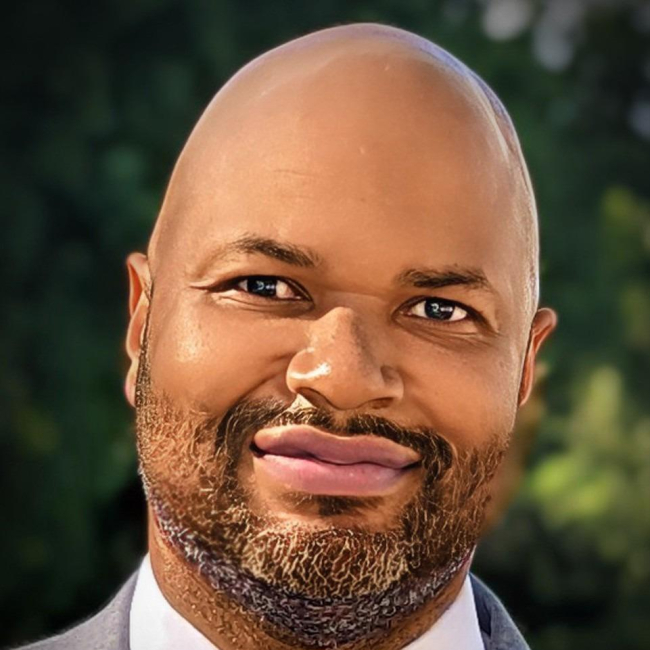
Terence Lynch
Terence Lynch, Ph.D., is the Director of the newly established Office of Science Support with NOAA Research. Formerly, he was the acting Deputy Director of NOAA’s Office of Ocean Exploration Research and spent 14 years in NOAA’s Office of Coast Survey. With expertise in budget formulation/execution, legislative engagement, strategic planning, and advocating for diversity and inclusion, Lynch understood the importance of professional development and challenging himself which has helped him in his career. Having had the experience to serve in multiple leadership roles within the federal government, Lynch credits his selection as a 2017 Excellence in Government Fellow with the Partnership for Public Service with helping to expand his federal network and providing a broader knowledge of other agency successes and challenges.
Describe a DPAWG activity that you’re particularly proud of.
I would say ORDERS, the TOol foR Diverse IntERview PanelS. It’s an effort that Alisa Young from the National Environmental Satellite and Data Information Service (NESDIS) and I began in 2016-2017, which is now gaining traction throughout the agency. The concept of diverse panels came up around 2017-ish in the National Ocean Service, who I was working with at the time. We developed guidance in terms of how to construct hiring panels, but one of the challenges of constructing a panel was, who could we get to serve? What we found is that we were recycling through the same persons, and we wanted others to have an opportunity to serve. With ORDERS, we were able to create a “menu/catalog” from which managers and hiring officials could select and create their hiring panels. So with that, ORDERS was birthed, and the focus has since been on marketing and eventual adoption of the tool throughout NOAA. Alisa Young and I worked internally with DPAWG to create that menu, and we then expanded it to include the other ERGs within NOAA. At present, we have ~90 people who are a part of ORDERS and available to serve as panelists and contribute to the hiring process.
We were fortunate to have the support of Dr. Stephen Volz, Assistant Administrator for NESDIS, who recognized the value of ORDERS and just completed a one year successful pilot within NESDIS of the tool. We found that a number of hiring officials were unaware the tool existed, so we have to do a better job with making people aware of ORDERS. One way the ORDERS team has marketed the tool is by presenting at the August 24, 2022 NOAA Central Library Seminar Series via a request from Vankita Brown, NOAA Senior Advisor for Equity. In the future, we hope to secure support for agency-wide adoption of the tool.
How has DPAWG impacted you personally and professionally?
I’ve been one of the co-chairs for the advancement and retention committee since its inception. One of the things that really excites me about being part of this group is seeing the advancement of its members and watching them progress throughout the agency. It’s disheartening when some of our brightest talents aren’t extended opportunities within the agency and they have to go elsewhere. But we’ve had some success on both retention and advancement over the years. It also speaks to challenging yourself in order to continue your development. So that’s what we try to do — we try to challenge one another. When I look at DaNa Carlis, Lonnie Gonsalves, LaToya Myles, and myself — we were able to get our promotions within possibly a year of one another. These opportunities allow us to change the narrative and dispel the notion that there is a lack of qualified minorities in the talent pipeline to serve in leadership roles. We have to continue to do our part with encouraging and ensuring that others are preparing themselves to follow in our footsteps.
Yes, NOAA has some challenges when it comes to the advancement of persons of color or underrepresented groups, but we are making progress. I think that what happened with us speaks to the incremental progress that’s being made. We’re just now seeing those breakthroughs, and that’s what excites me and gives others hope: seeing the advancement of persons within our ERG who we view as family.

John Moore
John Moore is a Public Affairs Meteorologist/Specialist with NOAA’s Office of Communications at NWS headquarters. He specializes in communication, public outreach, social media, diversity and societal-cultural impacts of the services provided by the weather community. He knew he wanted to be a meteorologist since he was a child.
Describe a DPAWG activity that you’re particularly proud of.
One activity that I am particularly proud of is the 20% Podcast that I developed with my colleague Janae Elkins. I actually mentored Janae when she was in college. I was just starting out in DPAWG and helped her get into the agency. We ended up working in the same office, so we have that background and friendship with each other already that helped the podcast blossom. We had the idea because we were in a field office isolated from the rest of DPAWG, and we wanted a way to be able to connect DPAWG members. Through that podcast, we were able to have some engaging conversations with a lot of our fellow DPAWG colleagues. Those conversations started out as very surface conversations, but before long, we were having really great, in-depth conversations surrounding multiple topics inside and outside of NOAA. Over the pandemic, it became a safe place, not only for Janae and me but for other people in DPAWG to share their thoughts on the ongoing situation. I’m really proud of that.
Another thing that I’m particularly proud of is that, in 2020, one of my colleagues and I hosted a resume and interview workshop for DPAWG members. I’m not an expert on resumes, but some of the information that I was able to pass along really helped some of my other colleagues in NOAA. I’m very proud that I was actually invited to some of the other ERGs to give the same resume-building presentation, and I still give it to this day.
How has DPAWG impacted you personally and professionally?
It has had a profound impact on my life professionally and personally. I joined DPAWG in 2016, and I was able to quickly build relationships with DPAWG members. It helped fight a feeling of isolation because, being a young minority in a field office at NOAA, you’re oftentimes the only person of color. So I was able to connect with other people of color, people from different walks of life from DPAWG, and work on projects that have benefitted NOAA as a whole. Forming those relationships with other people who look like me, talk like me, sound like me, definitely helped my time as an early-career employee. I have made some tremendous friendships through DPAWG. DPAWG was the main reason that I pursued a career at NOAA headquarters. The network I formed through DPAWG made me aware of every opportunity that I’ve gotten since I joined. Moving to the DC area, it helped out having people already here who could help welcome me to the office. With this recent promotion, DPAWG really helped me with the transition to public affairs.

Ashley Turnbull
Ashley Turnbull is an Education Evaluator with NOAA’s Office of Education, providing technical assistance to higher education programs to achieve strategic goals and objectives. As a former teacher, she has a passion for ensuring quality and equitable education for students from minoritized communities. Outside of her work at NOAA, Ashley is pursuing a doctorate degree in Educational Psychology, and develops curriculum for after school programs designed to support students’ social, emotional, and educational development.
Describe a DPAWG activity that you’re particularly proud of.
I can talk about DPA’s efforts in collaborating with other ERGs. I am proud of that. I think the group has done a great job of coming together with other ERGs and leadership to talk through some of the issues that we’re passionate about and the efforts that we’re working on. ERGs are working groups throughout NOAA that NOAA staff can join. Typically, they represent some sub-community of NOAA: you have the African American ERG, Veterans of NOAA, Latinos@NOAA, among others. All of these ERGs have their own goals and objectives.
While there are some nuances, I’ve found that we’re working towards similar efforts that support NOAA’s broader mission, like recruitment and career advancement. I think that the group has done a great job of identifying the needs of its members, being transparent about what do we need and what are the barriers that are hindering us from getting there, and then truly working toward solutions to resolve them and utilizing our resources through other ERGs to come up with solutions.
How has DPAWG impacted you personally and professionally?
I joined DPAWG not long after I got hired, so I feel like I was still very much learning the ropes of my own position and my own office. Being part of DPAWG, and on the executive committee in particular, taught me a lot about the agency as a whole and how to navigate certain spaces. Within my office, I feel comfortable and supported by my supervisor and my peers, but I think being in a space where most of the members look like me and have different experiences within NOAA has been really helpful as well. It has formed a sense of belonging that I wouldn’t have had otherwise. I really appreciate that level of support; it’s like a family. I don’t get to engage with people in the office often, but DPAWG provides that sense of community, especially in a virtual workplace. Being surrounded by people who care about my development both professionally and personally — I value that. For example, Vankita consistently checks in with me about how school is going or personally how things are going, and openly offers resources when she can. I’m able to take a step back, even when I’m at work, and recognize that we’re not just the positions that we fill, we are human beings. Being part of DPAWG really embodies the essence of this and takes into account a holistic perspective of caring for each other in the workspace.



